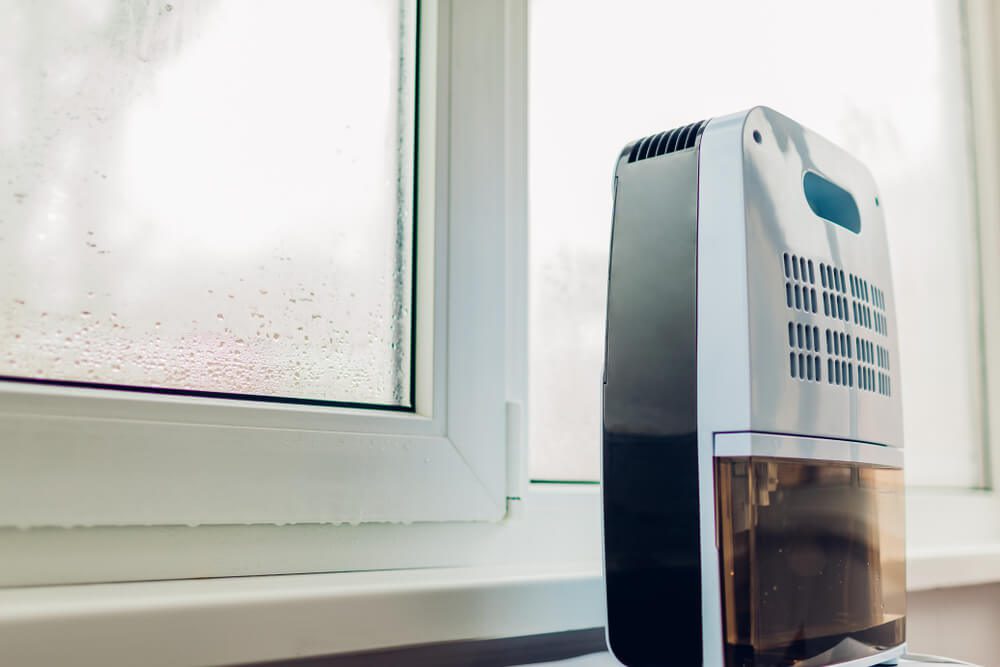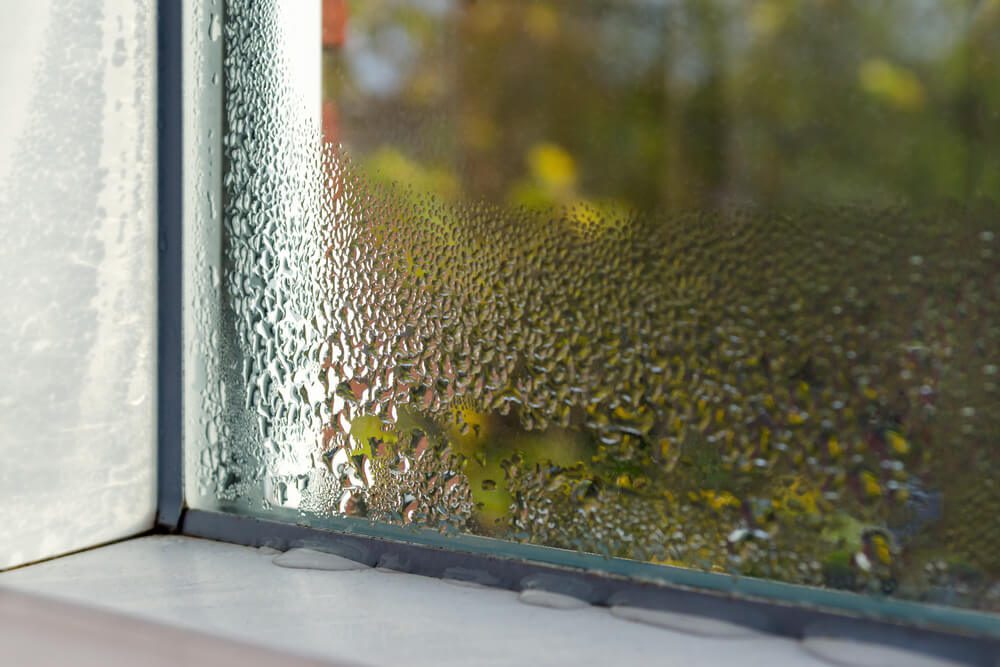Blog
Whole House vs. Portable Dehumidifiers: Which Is Right for You?

Summers are hot and, worst of all, humid. The water feels heavy in the air, which makes it very difficult to cool down. Keeping humidity under control in your home is important for your comfort and protecting your home from mold and rot. Dehumidifiers separate water from air, allowing for easier breathing and more comfort.
Whether you need a portable or whole-home dehumidifier will depend on how much excess humidity is in your home. Air conditioning units naturally remove water from the air while they run, but it may not be enough to achieve the humidity level you’re looking for.
To help you decide between a portable or whole-house dehumidifier, here are some pros and cons of each.
Pros and Cons of Portable Dehumidifiers

Many homeowners wonder if a portable dehumidifier can work for a whole house. Portable dehumidifiers come with their own set of advantages and disadvantages, and can still be a great option depending on your needs.
Advantages of Portable Dehumidifiers
Portable dehumidifiers can offer a number of benefits, including:
- Lower initial cost
- More control over the humidity in a specific area
- Portable and easy to move around
- Faster and easier to install and operate
One of the largest appeals of portable dehumidifiers is the lower initial cost. You can go to a home improvement store and buy one in the $120 to $500 range.
Portable dehumidifiers offer more control if you need to adjust the humidity in a specific room, such as in a basement or a room with mold problems. If you have a space where you're fighting mold, consider checking for leaks in your plumbing.
Stand-alone dehumidifiers can be moved from room to room as necessary and are particularly handy for spills in carpets and other accidents. Fans can evaporate the water from the carpet, but it still needs to be pulled from the air, or it will cycle back into other objects.
Finally, portable dehumidifiers are extremely simple to install and operate. Simply plug in the unit and let it run until you have to empty the water basin. They are great for smaller areas or in rental apartments where you don’t have permission to install equipment permanently.
Disadvantages of Portable Dehumidifiers
Unfortunately, there are a few disadvantages of portable dehumidifiers that you’ll need to consider, such as:
- Limited square foot coverage
- Shorter lifespan than a whole-home dehumidifier
- Louder during operation
- Water must be emptied regularly, or the dehumidifier itself must be placed high so that gravity can be used to push the water into a drain
- Less energy efficient
- Higher maintenance, as they have to be regularly cleaned to prevent mold
Portable dehumidifiers operate in a single room at a time. The larger the room, the more capacity or units you need to control the humidity. Portable dehumidifiers will advertise coverage of anything from 200 to 2,000 square feet.
Can a single portable unit cover 2,000 square feet and keep the humidity down? Well, the way that portable dehumidifiers are marketed would lead you to believe that they should be able to handle all your humidity woes. However, a single portable dehumidifier can't cover that much square footage—even if the room was fully sealed, had excellent air circulation, and wasn't overly humid to begin with.
In our experience, with humidity in the 65 to 75 percent range and 2,000 square feet, you will need a minimum of six portable dehumidifiers to get the humidity down to anywhere near 55 percent. That is assuming the 2,000 feet is a single room without walls to block airflow. A single, portable basement dehumidifier is not enough to help the whole house.
Dehumidifiers need a strong fan to pull air through and remove the water. The unit needs to be out in the open, with at least 12 inches between itself and the wall, to get proper air circulation. The fan is just as loud as you think a strong fan would be. Even with a strong fan, portable dehumidifier fans don’t have the strength to move the air in a large room and will only affect a portion of it, even if they have the moisture removal capacity.
The portable dehumidifier has to put the water it pulls out somewhere. Most will come with a hose or a water container. To use the hose, the dehumidifier will need to be set up close to a drain, and it will need to have some level of height advantage to get gravity to drain the water down.
Otherwise, the water container will need to be emptied when it fills up—about every two to four hours in a high-speed setting. The bucket has standing water in it for long periods of time and will need to be cleaned out monthly to avoid mold growth. The hose would only need occasional cleaning—perhaps once a year, depending on the materials and conditions.
Finally, dehumidifiers work similarly to air conditioners and use quite a bit of electricity. The portable dehumidifiers are just as inefficient as window AC units. Their smaller size creates much greater energy inefficiency and costs more to run.
Pros and Cons of Whole-House Dehumidifiers

Whole-home dehumidifiers are a great alternative to portable units. It’s important to consider the benefits and drawbacks of these types of dehumidifiers if you’re thinking about installing one in your home.
Advantages of a Whole-Home Dehumifidier
There are many benefits of a whole-house dehumidifier, including:
- Greater capacity to control the humidity of your entire house rather than a single room
- Located with the HVAC system, out of sight with lower sound levels
- Lower maintenance, since water is drained directly into your plumbing system
- Up to four times more energy efficient than a portable dehumidifier
- Longer service life
A stand-alone whole-home dehumidifier has significantly increased efficiency and capacity compared to a portable dehumidifier. Like an AC unit, the capacity and size of a house dehumidifier can be adjusted for both large and small homes. The advertised capacity of a whole-home dehumidifier is based on the amount of moisture it can remove from 80-degree air with 60 percent relative humidity.
Most whole-home dehumidifiers take advantage of a home’s central air ductwork system and simply pull humidity out of the air before it gets vented into the rooms. Because your HVAC system is hidden away, the dehumidifier is out of sight and has reduced noise pollution.
Most dehumidifiers will drain the water into your yard or drainage system. The hose and pieces should be cleaned at the end of the humidity season.
These larger home dehumidifiers are significantly more energy efficient than their portable, stand-alone counterparts and offer a much longer service life. Most portable dehumidifiers have a lifespan of around five years, depending on how heavily they are used. Whole-home dehumidifiers last around eight to 15 years, depending on how heavily they're used and how often filters are cleaned and changed.
Disadvantages of Whole-House Dehumidifiers
On the other hand, disadvantagese of these units may include:
- Initial cost is much higher
- Requires professional installation
- Difficult to take with you if you move homes
According to Forbes, the average cost of a new whole-home dehumidifier in the United States is around $1,000 to $3,000. The capacity, brand, and efficiency rating will all affect the price.
Whole-home dehumidifiers need to be professionally installed. Installation will take somewhere between four to six hours, depending on what it takes to install a drainage line, run power, and modify the existing ductwork. Most companies charge between $75 and $250 per hour for installation.
If you decide to move homes, you can, in theory, take the dehumidifier with you. Uninstalling the system costs about as much as installing it, so many homeowners decide to leave the system in place.
Do You Need a Whole-Home Dehumidifier?
Do you need a whole-home dehumidifier, or can you get a portable one? The answer, of course, is it depends.
How big of a space do you need to have humidity control? A portable dehumidifier may be enough to protect a closet or small work or storage area with your woodwork, paintings, or other collections. Portable dehumidifiers are also great for small apartment buildings when you don’t have permission to permanently install equipment.
We recommend considering a whole-home dehumidifier for areas larger than 900 square feet. They are significantly more energy efficient, take up less space, make less noise, require less maintenance, and pull out more water than portable units. We especially recommend whole-home dehumidifiers for medium and large-sized homes.
Apollo Home offers expert whole-home dehumidifier repair, replacement, and installation services in Cincinnati, Dayton, and Northern Kentucky. Contact us today to learn more.


